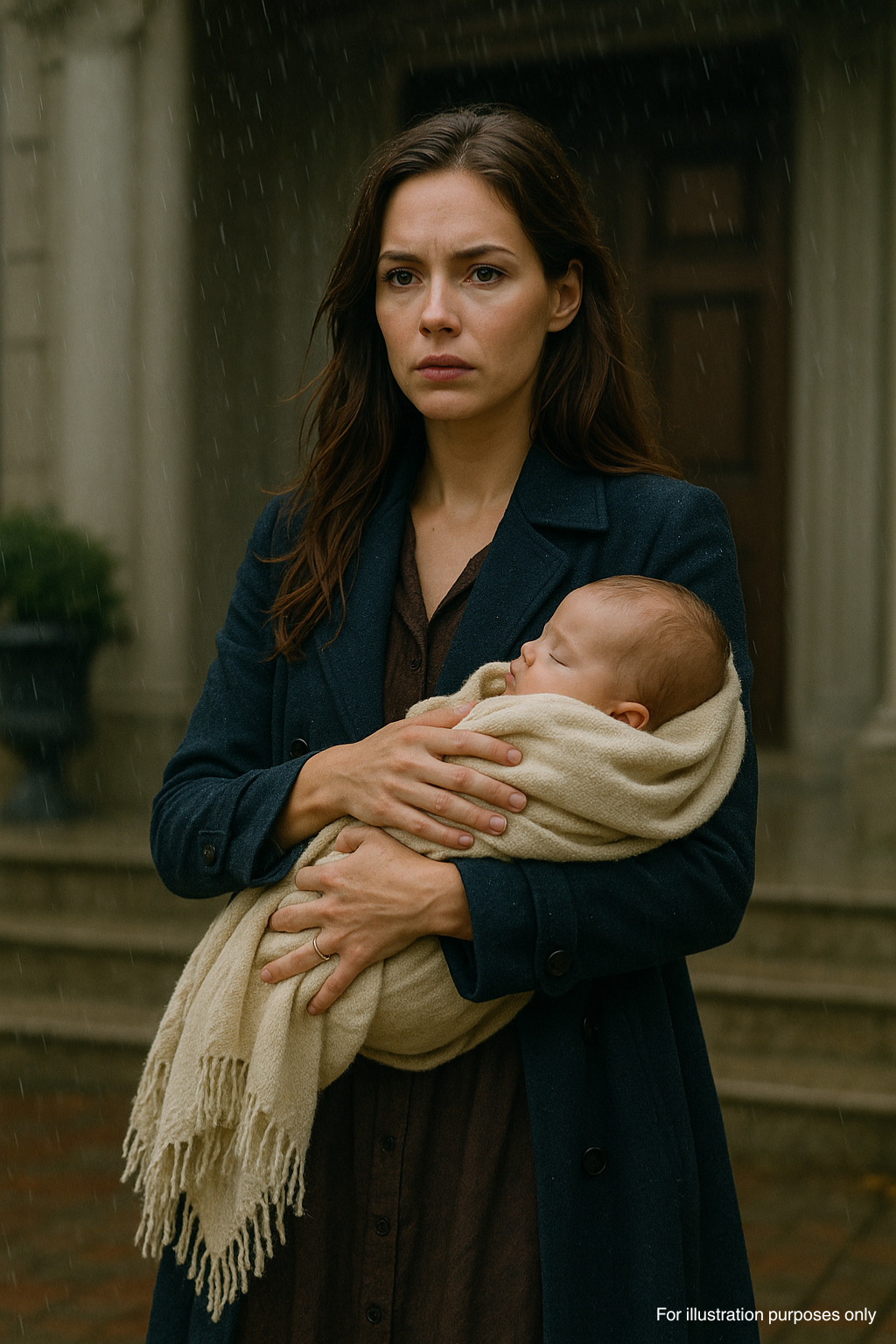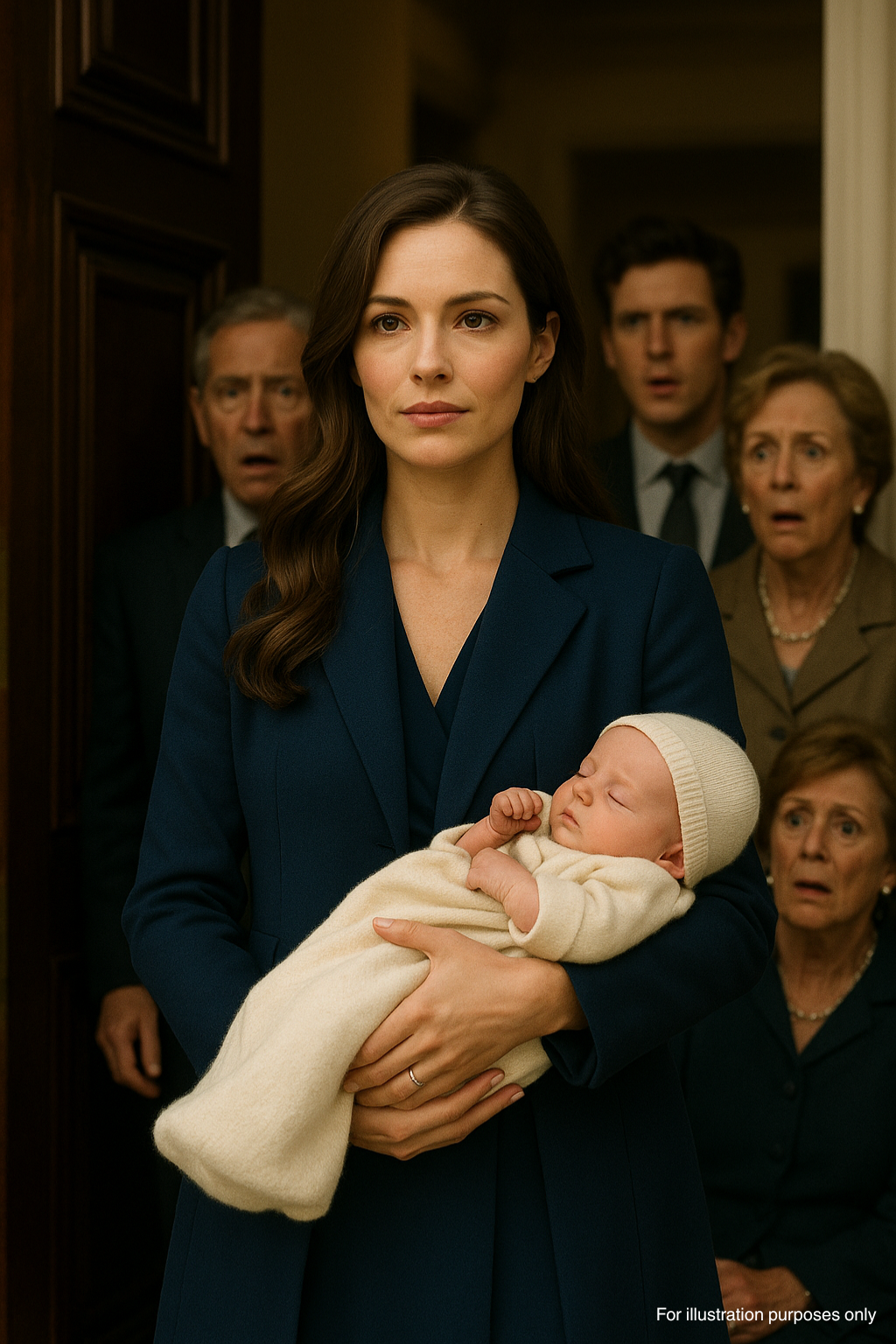The rain came down in sheets, cold and merciless, as Claire stood on the grand steps of the Whitmore estate. Her arms were shaking—not from the chill, but from holding her newborn son for hours. Her heart ached more than her body ever could.
Behind her, the massive oak doors slammed shut with a hollow finality.
Moments earlier, her husband Edward—Edward Whitmore III—stood alongside his equally heartless parents and delivered the blow.
“You’ve embarrassed this family,” his mother had said sharply. “This child was not part of the arrangement.”
“It’s over, Claire,” Edward added, refusing to meet her eyes. “We’ll have your things sent. Please leave.”
Claire had no words. Just tears. Her wedding had been fairy-tale perfect, but this was the ugly epilogue. She had left everything for him—her art, her freedom, her home—and now, discarded like a stain.
Her infant son stirred and whimpered. She tightened her grip and whispered, “Mommy’s here, sweetheart. I’ve got you. We’ll survive.”
They didn’t call a cab. They didn’t offer an umbrella. They just watched as she walked away into the storm.

The Rebuilding
Claire didn’t beg.
She slept in church pews and on overnight buses. Played violin in subway tunnels for coins. Sold her jewelry piece by piece—her wedding ring last.
She never gave up.
Eventually, she found a tiny room above a corner store. The landlady, Mrs. Talbot, took pity and let Claire stay in exchange for working the register downstairs.
By day, Claire worked. By night, she painted—using scraps of cardboard, leftover brushes, and discount acrylics. Her son, Nathaniel, slept in a laundry basket lined with towels beside her easel.
Life was hard. But it was honest. And slowly, painfully, she began to rebuild.
The Breakthrough
Three years later, at a street fair in Brooklyn, everything changed.
Vivian Grant, a high-profile gallery owner, was passing through when she spotted Claire’s paintings—lined up modestly against a wrought iron fence. She stopped cold.
“These are yours?” she asked.
Claire nodded, cautious.
“They’re… breathtaking,” Vivian said. “Raw. Wounded. Alive.”
That afternoon, Vivian bought three pieces and invited Claire to showcase her work.
Claire nearly declined—she had no dress, no sitter. But Mrs. Talbot pressed a garment bag into her hands and said, “Go. Shine.”
And she did.
The small exhibit turned into a wildfire of buzz. Media attention. Buyers. Critics. Claire’s name started appearing in magazines, interviews, art blogs.
Not once did she speak of revenge.
But she never forgot.
The Return
Five years after she’d been cast out, Claire walked through the grand glass doors of the Whitmore Family Foundation.
The organization was in trouble. Edward’s father had passed. Donations had dried up. Their reputation was stale.
They needed fresh faces. Bold ideas. And their PR team had invited an up-and-coming artist to collaborate on a high-profile exhibition.
They didn’t know who she was.
Claire walked in with quiet elegance. Dressed in navy silk. Nathaniel, now seven, held her hand.
When Edward saw her, he went pale. “Claire…?”
The assistant announced, “Miss Claire Whitmore. Our featured artist for this year’s gala.”
Claire gave a soft smile. “Hello, Edward. It’s been a while.”
He stood, stunned. “I… didn’t realize…”
“No,” she replied. “You didn’t.”
She placed a proposal on the table. “The collection is titled Unbroken. It’s about surviving abandonment. Motherhood. And healing without closure.”
She paused.
“And I want all proceeds to benefit shelters for women and children left without support.”
Silence fell.
Edward’s mother—now in a wheelchair—sat stiffly, unable to speak.
A board member leaned in. “Miss Whitmore… your proposal is remarkable. But won’t your history with this family complicate things?”
Claire’s voice was clear. “There is no history. I kept only one name—my son’s.”
Edward tried to speak. “Claire… about Nathaniel—”
She turned, her gaze steady. “He’s thriving. Talented. Kind. And he knows exactly who stayed… and who didn’t.”
The board approved the exhibition without hesitation.
The Masterpiece
A month later, the gallery opened inside a repurposed church. Crowds lined up around the block.
The centerpiece: a canvas titled Exile.
It showed a woman in the rain, clutching a baby outside a palace, its doors just closing behind her. Her face wasn’t desperate—it was determined. A golden thread wrapped around her wrist, trailing into the clouds above.
Critics called it “a triumph of survival and defiance.”

The Encounter
On the final night, Edward showed up.
Alone.
He stood silently before Exile, then turned—and found Claire standing nearby, a glass of wine in hand.
“I never wanted this to happen,” he said quietly.
“I know,” Claire replied. “But you let it.”
“I was scared… My parents—”
Claire raised a hand. “No excuses. I stood in the rain with your child, and you closed the door. That choice was yours.”
He swallowed. “Is there… any chance I could know him? Nathaniel?”
She looked at him—not with anger, but with resolve.
“Not up to me. Maybe one day, if he chooses. But don’t wait for it.”
Edward nodded slowly. “He still plays violin?”
She smiled. “Piano now. Chopin. He plays beautifully.”
Tears filled his eyes. “Tell him I’m sorry.”
“I will,” she said. “Maybe.”
Then she turned, calm and dignified, and walked away.
The Legacy
Years later, Claire founded The Unbroken House — a sanctuary for single mothers and displaced children.
She never sought revenge. She built hope.
One evening, as she tucked fresh blankets into a room for a young mother and her newborn, she glanced out the window.
Nathaniel, now twelve, was in the courtyard, laughing with other children under the golden light of sunset.
Claire watched for a long moment, her heart full.
“They thought they were casting me out,” she whispered.
“But really… they were setting me free.”
